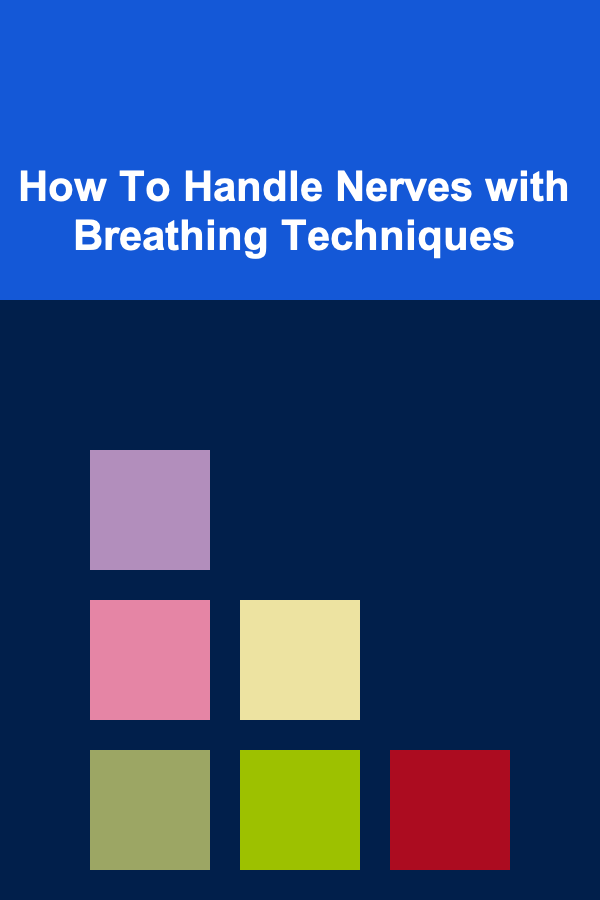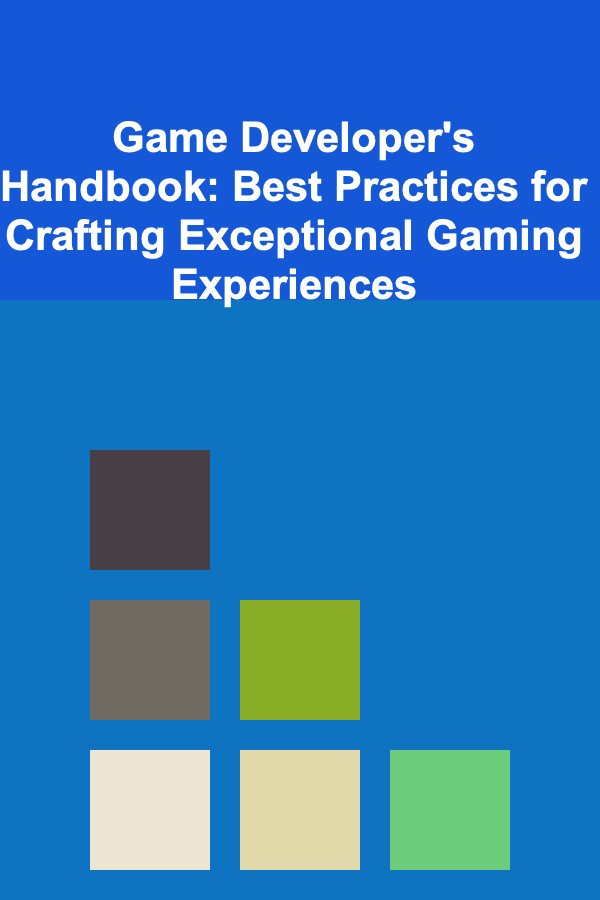
How To Handle Nerves with Breathing Techniques
ebook include PDF & Audio bundle (Micro Guide)
$12.99$10.99
Limited Time Offer! Order within the next:

Nerves are a ubiquitous part of the human experience. From minor anxieties about a presentation to crippling fear before a significant life event, nervousness affects us all. While a certain level of apprehension can be beneficial, pushing us to prepare and perform at our best, excessive nervousness can be debilitating, impacting our performance, decision-making, and overall well-being. Fortunately, we possess an innate tool to combat this: our breath. Breathing techniques, often overlooked in their potential, offer a powerful and accessible means of managing anxiety and calming the nervous system.
The Physiology of Nerves and the Breath
To understand how breathing techniques can help alleviate nerves, it's crucial to first grasp the physiological mechanisms at play. When we experience stress or anxiety, our body activates the sympathetic nervous system, often referred to as the "fight-or-flight" response. This response triggers a cascade of physiological changes designed to prepare us for immediate action. These changes include:
- Increased heart rate: To pump more blood to muscles and organs.
- Rapid breathing: To deliver more oxygen to the body.
- Muscle tension: Preparing the body for physical exertion.
- Release of stress hormones: Such as cortisol and adrenaline, which further amplify the physiological responses.
While these responses are adaptive in the face of genuine threats, they can become maladaptive when triggered by perceived threats or chronic stress. The symptoms of the fight-or-flight response -- racing heart, shallow breathing, sweaty palms, and a sense of panic -- can significantly impair our ability to think clearly and perform effectively. The breath, however, provides a direct link to the autonomic nervous system, allowing us to consciously influence these physiological processes.
The autonomic nervous system has two primary branches: the sympathetic nervous system (the "fight-or-flight" response) and the parasympathetic nervous system (the "rest-and-digest" response). Breathing techniques, particularly slow, deep breathing, stimulate the parasympathetic nervous system, counteracting the effects of the sympathetic nervous system. This stimulation leads to:
- Decreased heart rate: Promoting relaxation and reducing the feeling of panic.
- Slower, deeper breathing: Increasing oxygen intake and promoting a sense of calm.
- Muscle relaxation: Reducing tension and promoting physical comfort.
- Reduced stress hormone levels: Mitigating the physiological effects of anxiety.
By consciously manipulating our breathing, we can effectively "hack" our nervous system, shifting from a state of anxiety and hyper-arousal to a state of calm and relaxation. This control over our physiological state allows us to regain mental clarity and improve our ability to cope with stressful situations.
Specific Breathing Techniques for Managing Nerves
Numerous breathing techniques can be employed to manage nerves. Here are some of the most effective and widely practiced methods:
1. Diaphragmatic Breathing (Belly Breathing)
Diaphragmatic breathing, also known as belly breathing, is a foundational technique for calming the nervous system. It involves engaging the diaphragm, the primary muscle involved in breathing, to facilitate deeper and more efficient respiration.
How to practice diaphragmatic breathing:
- Find a comfortable position, either sitting or lying down.
- Place one hand on your chest and the other on your abdomen, just below your ribs.
- Inhale slowly and deeply through your nose, allowing your abdomen to rise while keeping your chest relatively still. You should feel the hand on your abdomen moving upward while the hand on your chest remains mostly stationary.
- Exhale slowly and completely through your mouth, allowing your abdomen to fall.
- Continue breathing in this manner for several minutes, focusing on the movement of your abdomen and the sensation of the breath entering and leaving your body.
Benefits of diaphragmatic breathing:
- Reduces heart rate and blood pressure.
- Promotes relaxation and reduces muscle tension.
- Increases oxygen intake and improves lung capacity.
- Reduces feelings of anxiety and stress.
- Improves focus and concentration.
Diaphragmatic breathing can be practiced anywhere and anytime, making it a valuable tool for managing nerves in various situations. It is particularly effective when practiced regularly, even when you are not feeling anxious, to build a foundation of calm and resilience.
2. 4-7-8 Breathing (Relaxing Breath)
The 4-7-8 breathing technique, popularized by Dr. Andrew Weil, is a simple yet powerful method for promoting relaxation and reducing anxiety. It involves a specific pattern of inhalation, breath retention, and exhalation that helps to slow the heart rate and calm the mind.
How to practice 4-7-8 breathing:
- Find a comfortable position, either sitting or lying down.
- Place the tip of your tongue against the ridge of tissue just behind your upper front teeth, and keep it there throughout the exercise.
- Exhale completely through your mouth, making a "whoosh" sound.
- Close your mouth and inhale quietly through your nose for a count of 4.
- Hold your breath for a count of 7.
- Exhale completely through your mouth, making a "whoosh" sound, for a count of 8.
- Repeat this cycle at least four times.
Benefits of 4-7-8 breathing:
- Slows down the heart rate and promotes relaxation.
- Reduces feelings of anxiety and stress.
- Improves sleep quality.
- Lowers blood pressure.
- Can be used to manage panic attacks.
The 4-7-8 breathing technique is particularly effective for calming the mind before sleep or during moments of heightened anxiety. It is important to practice this technique regularly to reap its full benefits.
3. Box Breathing (Square Breathing)
Box breathing, also known as square breathing, is a technique used by Navy SEALs and other high-performance individuals to manage stress and improve focus in high-pressure situations. It involves visualizing a square and using each side to represent a different phase of the breathing cycle.
How to practice box breathing:
- Find a comfortable position, either sitting or lying down.
- Close your eyes and visualize a square.
- Inhale slowly and deeply through your nose for a count of 4, visualizing the first side of the square.
- Hold your breath for a count of 4, visualizing the second side of the square.
- Exhale slowly and completely through your mouth for a count of 4, visualizing the third side of the square.
- Hold your breath for a count of 4, visualizing the fourth side of the square.
- Repeat this cycle for several minutes, focusing on the visualization of the square and the sensation of the breath.
Benefits of box breathing:
- Calms the nervous system and reduces stress.
- Improves focus and concentration.
- Increases mental clarity.
- Regulates heart rate and blood pressure.
- Can be used to manage anxiety and panic attacks.
Box breathing is a versatile technique that can be used in a variety of situations, from preparing for a stressful meeting to managing anxiety during a presentation. The visualization aspect of the technique can also help to distract the mind from negative thoughts and promote a sense of calm.
4. Alternate Nostril Breathing (Nadi Shodhana Pranayama)
Alternate nostril breathing, known as Nadi Shodhana Pranayama in yoga, is a technique that balances the energy flow in the body and calms the mind. It involves alternately closing one nostril while breathing through the other.
How to practice alternate nostril breathing:
- Find a comfortable seated position.
- Close your right nostril with your right thumb.
- Inhale slowly and deeply through your left nostril.
- Close your left nostril with your right ring finger and release your right thumb.
- Exhale slowly and completely through your right nostril.
- Inhale slowly and deeply through your right nostril.
- Close your right nostril with your right thumb and release your right ring finger.
- Exhale slowly and completely through your left nostril.
- This completes one cycle. Continue breathing in this manner for several minutes, alternating nostrils with each breath.
Benefits of alternate nostril breathing:
- Calms the mind and reduces stress.
- Balances the nervous system.
- Improves focus and concentration.
- Reduces anxiety and promotes relaxation.
- Clears the nasal passages.
Alternate nostril breathing is a particularly effective technique for balancing the energy flow in the body and promoting a sense of calm and well-being. It is often used in yoga and meditation practices.
5. Lion's Breath (Simhasana)
Lion's breath, or Simhasana in yoga, is a more dynamic breathing exercise that involves exhaling forcefully through the mouth while sticking out the tongue. While seemingly unusual, it can be surprisingly effective at releasing tension and stimulating the vagus nerve, which plays a crucial role in regulating the parasympathetic nervous system.
How to practice Lion's Breath:
- Kneel on the floor or sit in a comfortable seated position.
- Press your palms onto your knees or the floor, spreading your fingers wide.
- Inhale deeply through your nose.
- Open your mouth wide and stick out your tongue, as if roaring like a lion.
- Exhale forcefully through your mouth, making a "ha" sound.
- Focus your gaze on the tip of your nose or between your eyebrows.
- Repeat this exercise several times.
Benefits of Lion's Breath:
- Releases tension in the face, neck, and shoulders.
- Stimulates the vagus nerve and promotes relaxation.
- Improves vocal clarity.
- Can help to relieve stress and anxiety.
- May improve digestion.
Lion's breath is a powerful and invigorating technique that can be used to release pent-up emotions and promote a sense of well-being. It's a great option when you need a quick and effective way to release tension and boost your mood.
Integrating Breathing Techniques into Your Daily Life
The key to effectively managing nerves with breathing techniques is to integrate them into your daily life. Don't wait until you're feeling overwhelmed to start practicing. Regular practice will make these techniques more accessible and effective when you need them most.
Here are some tips for incorporating breathing techniques into your routine:
- Schedule dedicated practice time: Set aside 5-10 minutes each day to practice your chosen breathing technique. Treat this time as an important appointment that you won't miss.
- Use breathing techniques during moments of stress: When you feel your nerves starting to rise, take a few moments to practice diaphragmatic breathing, 4-7-8 breathing, or box breathing.
- Practice mindfulness: Pay attention to your breath throughout the day. Notice the sensations of the air entering and leaving your body. This awareness will help you to become more attuned to your body's signals of stress and anxiety.
- Combine breathing techniques with other relaxation practices: Meditation, yoga, and progressive muscle relaxation can all complement breathing techniques and enhance their effectiveness.
- Experiment to find what works best for you: Different breathing techniques work better for different people. Experiment with different methods to find the ones that you find most effective and enjoyable.
- Be patient and persistent: It takes time and practice to master breathing techniques and to experience their full benefits. Don't get discouraged if you don't see results immediately. Keep practicing regularly, and you will eventually notice a significant improvement in your ability to manage your nerves.
For example, before a presentation, find a quiet space and practice box breathing for a few minutes. This can help to calm your nerves and improve your focus. During a stressful workday, take a few moments to practice diaphragmatic breathing at your desk. This can help to reduce tension and improve your concentration. Before bed, practice 4-7-8 breathing to promote relaxation and improve sleep quality.
Beyond Breathing: A Holistic Approach to Managing Nerves
While breathing techniques are a powerful tool for managing nerves, they are most effective when combined with a holistic approach to well-being. This includes addressing other factors that can contribute to anxiety and stress, such as:
- Healthy diet: A balanced diet rich in fruits, vegetables, and whole grains can help to regulate mood and reduce anxiety. Avoid processed foods, sugary drinks, and excessive caffeine, which can exacerbate anxiety symptoms.
- Regular exercise: Exercise is a natural stress reliever. It releases endorphins, which have mood-boosting effects, and helps to reduce muscle tension. Aim for at least 30 minutes of moderate-intensity exercise most days of the week.
- Adequate sleep: Lack of sleep can significantly increase anxiety and stress. Aim for 7-9 hours of quality sleep each night. Establish a regular sleep schedule and create a relaxing bedtime routine.
- Stress management techniques: In addition to breathing techniques, explore other stress management techniques such as meditation, yoga, mindfulness, and journaling.
- Social support: Connecting with supportive friends and family members can provide a buffer against stress and anxiety. Talk to someone you trust about your feelings and seek support when you need it.
- Professional help: If you are struggling to manage your nerves on your own, consider seeking professional help from a therapist or counselor. Cognitive Behavioral Therapy (CBT) and other therapies can be highly effective in treating anxiety disorders.
By addressing these factors in conjunction with practicing breathing techniques, you can create a comprehensive strategy for managing your nerves and promoting overall well-being.
Conclusion
Nerves are a common and often challenging aspect of life. However, by understanding the physiological mechanisms underlying anxiety and learning to harness the power of our breath, we can effectively manage our nerves and improve our overall well-being. Breathing techniques, such as diaphragmatic breathing, 4-7-8 breathing, box breathing, and alternate nostril breathing, provide a readily accessible and effective means of calming the nervous system and promoting relaxation. By integrating these techniques into our daily lives and adopting a holistic approach to well-being, we can cultivate a sense of calm, resilience, and control over our emotional state, allowing us to navigate the challenges of life with greater ease and confidence.
Remember, managing nerves is a journey, not a destination. Be patient with yourself, practice regularly, and celebrate your progress along the way. With consistent effort, you can learn to master your breath and master your nerves.

Game Developer's Handbook: Best Practices for Crafting Exceptional Gaming Experiences
Read More
How to Create an Organized Travel Packing System
Read More
How to Make the Most of Small Spaces with Holiday Decorations
Read More
How to Manage Your Home Budget When Moving to a New House
Read More
How to Make a Perfect Roux: The Essential Guide
Read More
How to Ace Your Government Job Application Checklist
Read MoreOther Products

Game Developer's Handbook: Best Practices for Crafting Exceptional Gaming Experiences
Read More
How to Create an Organized Travel Packing System
Read More
How to Make the Most of Small Spaces with Holiday Decorations
Read More
How to Manage Your Home Budget When Moving to a New House
Read More
How to Make a Perfect Roux: The Essential Guide
Read More